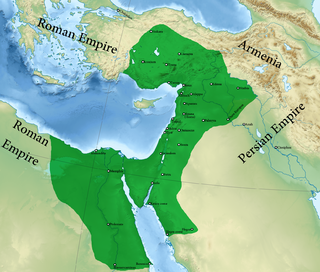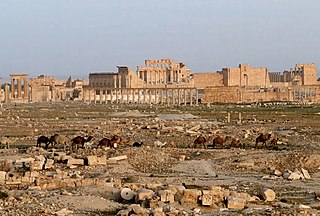
Religion in pre-Islamic Arabia included indigenous Arabian polytheism, ancient Semitic religions, Christianity, Judaism, Mandaeism, and Zoroastrianism.

Bêl is a title signifying "lord" or "master" applied to various gods in the Mesopotamian religion of Akkad, Assyria, and Babylonia. The feminine form is Bêlit in Akkadian. Bel is represented in Greek as Belos and in Latin as Belus. Belit appears in Greek form as Beltis (Βελτις). Linguistically, Bel is an East Semitic form cognate with the Northwest Semitic Baal with the same meaning.

Atargatis was the chief goddess of northern Syria in Classical antiquity. Primarily she was a fertility goddess, but, as the baalat ("mistress") of her city and people she was also responsible for their protection and well-being. Her chief sanctuary was at Hierapolis, modern Manbij, northeast of Aleppo, Syria.

Dura-Europos was a Hellenistic, Parthian, and Roman border city built on an escarpment 90 metres above the southwestern bank of the Euphrates river. It is located near the village of Salhiyé, in present-day Syria. Dura-Europos was founded around 300 BC by Seleucus I Nicator, who founded the Seleucid Empire as one of the Diadochi of Alexander the Great. In 113 BC, Parthians conquered the city, and held it, with one brief Roman intermission, until 165 AD. Under Parthian rule, it became an important provincial administrative centre. The Romans decisively captured Dura-Europos in 165 AD and greatly enlarged it as their easternmost stronghold in Mesopotamia, until it was captured by the Sasanian Empire after a siege in 256–57 AD. Its population was deported, and the abandoned city eventually became covered by sand and mud and disappeared from sight.

The Palmyrene Empire was a short-lived breakaway state from the Roman Empire resulting from the Crisis of the Third Century. Named after its capital city, Palmyra, it encompassed the Roman provinces of Syria Palaestina, Arabia Petraea, and Egypt, as well as large parts of Asia Minor.

Baalshamin, also called Baal Shamem and Baal Shamaim, was a Northwest Semitic god and a title applied to different gods at different places or times in ancient Middle Eastern inscriptions, especially in Canaan/Phoenicia and Syria. The title was most often applied to Hadad, who is also often titled just Ba‘al. Baalshamin was one of the two supreme gods and the sky god of pre-Islamic Palmyra in ancient Syria. There his attributes were the eagle and the lightning bolt, and he perhaps formed a triad with the lunar god Aglibol and the sun god Malakbel. The title was also applied to Zeus.

Malakbel was a sun god worshipped in the ancient Syrian city of Palmyra, frequently associated and worshipped with the moon god Aglibol as a party of a trinity involving the sky god Baalshamin.

The Temple of Bel, sometimes also referred to as the "Temple of Baal", was an ancient temple located in Palmyra, Syria. The temple, consecrated to the Mesopotamian god Bel, worshipped at Palmyra in triad with the lunar god Aglibol and the sun god Yarhibol, formed the center of religious life in Palmyra and was dedicated in AD 32. The temple would have been closed during the persecution of pagans in the late Roman Empire in a campaign against the temples of the East made by Maternus Cynegius, Praetorian Prefect of Oriens, between 25 May 385 to 19 March 388. Its ruins were considered among the best preserved at Palmyra, until they were further destroyed by the Islamic State in August 2015. The arched main entrance into the temple is still intact, as well as its exterior walls and fortified gate.
Abgal was a pre-Islamic Arabian god, whose worship is attested by inscriptions dating to the Palmyrene Empire – he is thought to have been primarily worshipped by nomads.

Sumatar Harabesi was an ancient watering place for semi-nomadic peoples located in the Tektek Mountains, 60 kilometers (37 mi) southeast of Urfa and 40 kilometers (25 mi) northeast of Harran, in modern-day Turkey. A now deserted oasis, it consists of a set of ruins and tombs situated around a central mount of rock 50 meters (160 ft) in height and width.

Yarhibol or Iarhibol is an Aramean god who was worshiped mainly in ancient Palmyra, a city in central Syria. He was depicted with a solar nimbus and styled "lord of the spring". He normally appears alongside Bel, who was a co-supreme god of Palmyra, and Aglibol, one of the other top Palmyrene gods.

Palmyra is an ancient city in the eastern part of the Levant, now in the center of modern Syria. Archaeological finds date back to the Neolithic period, and documents first mention the city in the early second millennium BC. Palmyra changed hands on a number of occasions between different empires before becoming a subject of the Roman Empire in the first century AD.
The Bene Komare were a Palmyrene tribe who were attested as one of the main four tribes of Palmyra.
The Bene Ma'zin were a Palmyrene tribe who were attested as one of the main four tribes of the city.
#NEWPALMYRA is an effort to reconstruct the ancient city of Palmyra as an immersive virtual environment, based on archaeological and other clues. The project was started from photos Bassel Khartabil had been taking of Palmyra since 2005. He began building models of the ancient city, with support from Al Aous Publishers. In 2012, Khartabil was arrested, and the original project and open source files were lost. Barry Threw took over as director of the project, renamed #NEWPALMYRA, and a community of developers, modelers, and archaeologists began collaborating to model, restore, and later recreate from scratch those historical structures captured on film and camera.
Septimius Haddudan was a 3rd-century Palmyrene official, the only known Palmyrene senator other than Odaenathus, and a priest and symposiarch of the god Bel, who is known to have opposed the rule of Queen Zenobia of Palmyra and aided the Roman Empire during their wars against the queen.

The Temple of the Gadde is a temple in the modern-day Syrian city of Dura-Europos, located near the agora. It contained reliefs dedicated to the protective deities of Dura-Europos and the nearby city of Palmyra, after whom the temple was named by its excavators. The temple was excavated between 1934 and January 1936 by the French/American expedition of Yale University, led by Michael Rostovtzeff.

The Temple of Bel, also known as the Temple of the Palmyrene gods, was located in Dura Europos, an ancient city on the Euphrates, in modern Syria. The temple was established in the first century BC and is celebrated primarily for its wall paintings. Despite the modern names of the structure, it is uncertain which gods were worshipped in the structure. Under Roman rule, the temple was dedicated to the Emperor Alexander Severus. In that period, the temple was located within the military camp of the XXth Palmyrene cohort.

The so-called necropolis temple was in the north of Dura-Europos, outside the city walls, about 150 m northwest of the main gate.

The Temple of Aphlad was an ancient temple located in the southwestern corner of Dura Europos, and dedicated to the god Aphlad. Aphlad was originally a Semitic Mesopotamian god from the city of Anath, and presence of his cult in Dura is revealing of its religious and cultural diversity. The temple itself consists of an open courtyard with multiple scattered rooms and altars, similar to the Temple of Bel, which was located in an analogous position in the northwestern corner of Dura.












